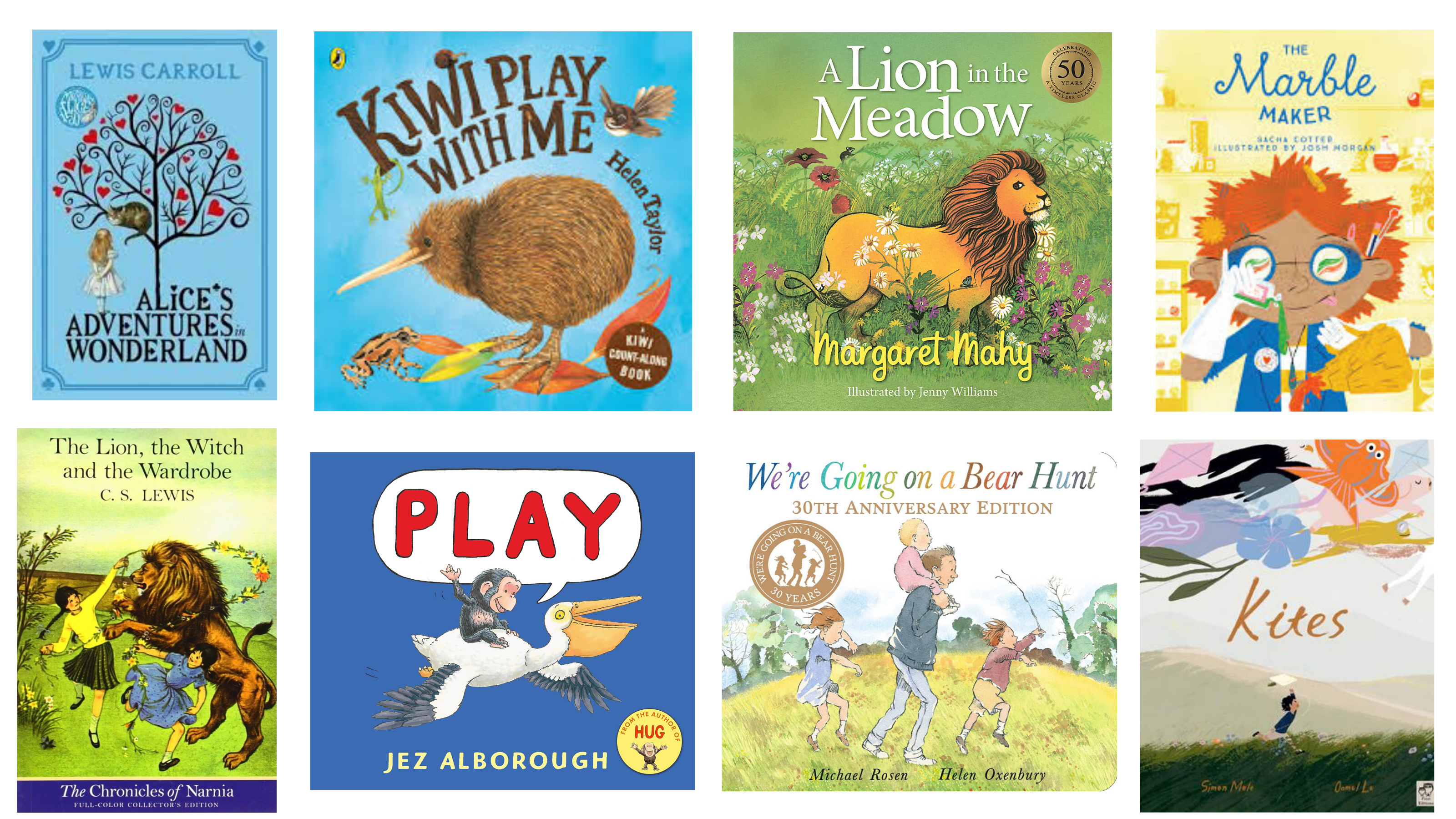In the last couple of months, we have seen the effects of COVID-19 wreak havoc worldwide. The mental health of both children and adults has been badly affected as we learn to cope with ‘the new normal’. One positive thing that has emerged through it all though, has been the renewed focus on children’s freedom to play.

Neuroscientists and educational experts, both in Aotearoa and internationally have advocated that giving children the opportunities to engage in uninterrupted play, nurtured resilience during the pandemic. While I watched my children play the day away, I reflected on how children’s books contribute to playfulness.
Almost all children’s books have a reference to play; direct or subtle. In many books, adventures happen when the children are at play! For instance, in C.S. Lewis’ The Lion, The Witch and The Wardrobe, Lucy stumbles across the wardrobe when exploring the Professor’s house while playing! In this feature, I look at play as it is represented in children’s books, specifically focusing on types of play, the games children play, and the things they play with.
Play is often characterised as being enjoyable and part of children’s identity. As children, we often ‘forgot’ to be back home at a time specified by our parents because we were so engrossed in it. Play by Jez Alborough is a story about Bobo, the adorable little chimp who doesn’t want to stop playing and eventually finds himself far away from home. The animals in the book are endearing, especially Bobo whose expressions are so child-like. The text in the story will resonate with very young children as they are usually monosyllables (play) or two-word sentences (such as sun going), as characteristic of children in the first two years. Kiwi play with me by Helen Taylor also is suited for very young readers with a playful kiwi reinforcing number concepts and counting.
The text in the story will resonate with very young children as they are usually monosyllables (‘play’) or two-word sentences (like ‘sun going’), characteristic of children in the first two years.
During the lockdown, I often heard my children say, ‘I’m bored!’. Wait a minute! Wasn’t it boredom that led Alice to follow the Rabbit with the pocket watch down the rabbit hole and to exciting Adventures in Wonderland? Research has proven that imagination and creativity often stem out of boredom. Developmentally, children especially in the early years engage in imaginary play which contribute towards creative thinking, problem solving, self-regulation and other executive function skills. Imagination and imaginary play often are perpetually represented in children’s literature. Margaret Mahy and Jenny Williams’ iconic A Lion in the Meadow is one such favourite of mine as it acknowledges imagination in play and it also reflects on the role of the significant adult who contributes by extending the child’s play too. Other classic books such as Judith Kerr’s The Tiger who came to Tea, Michael Rosen and Helen Oxenbury’s We’re Going on a Bear Hunt and Maurice Sendak’s Where the Wild Things Are are also centred in imaginary and make-believe play.
There has recently been a surge of books encouraging children to think creatively. Antoinette Portis’ Not a Box and Not a Stick, for instance, represent how children are able to symbolically transform simple, tangible objects into unique ones. Simple illustrations in both books could be used effectively with young children to promote their own creativity using open-ended questions and ‘I wonder…’ statements. As these books fit around what children already do, they see themselves being represented in what they read, giving them a sense of identity and belonging.
Simple illustrations in both books could be used effectively with young children to promote their own creativity using open-ended questions…
Playfulness has also been incorporated into the design of books. There has been a range of books that are targeted at young children which involve the child responding to prompts and text. Hervé Tullet’s interactive books offer children opportunities to be autonomous participants in the book. Let’s Play and Press Here as well as The Book with a Hole, to name a couple, empower children to interact with the images, engaging not only their kinaesthetic and visual senses but also their emotions as they experience emotions such as fun, fear, surprise and delight!

Another book that is playful in its structure and interactive, is The Book with No Pictures by B.J. Novak. The author cleverly only uses text to manipulate the reader to participate in the book. Closer to home, Vasanti Unka’s The Boring Book reminds the reader that books can be fun when children are left to enjoy them. One of the sentences that brings out the element of fun within the story particularly stands out:
‘We’re tired of standing still in rows. Let’s have fun instead!’
So they played…Hide and seek. Hide and seek is one of those games with rules that we played as children and our ancestors played before us! Anthony Browne’s book Hide and Seek uses the idea of siblings playing the game with the same emotional states experienced by children such as ‘what if they can’t find me?’ or ‘uh-oh, I need to go toilet!’ as well as the trepidation and impatience from the seeker when they cannot find them soon.
A similar theme is found in another Hide and Seek, by Polly Noakes however this book has a bit of a twist where the protagonist who originally is the seeker decides to hide herself! Both books are beautifully illustrated, nature being the focus in both books. In Fiona Woodcock’s Hiding Heidi, the protagonist loves a game of hide and seek and is quite the expert at making herself hidden (remember those friends who could do that?) but eventually realises that all games are fun, even if she isn’t great at them! The book has uncomplicated illustrations, almost like the stick-figure images we drew when we were little.
Both books are beautifully illustrated, nature beingthe focus in both books.
Play is often associated with playthings or toys. Over the lockdown period, we had our own bear-themed nation-wide movement, ‘NZ Bear Hunt’. Out came teddy bears of different sizes and other stuffed toys. Teddy bears are probably one of the most universal playthings ever. Gavin Bishop’s Teddy One-Eye (a chapter book aimed at older readers) and Diana Noonan and Elizabeth Fuller’s The Best-Loved Bear sentimentally describe the role of the bear as an object of comfort and constancy in the lives of children. In both books, the bear is loved to the point of it being in tatters but the sentiment remains; an inanimate object can still provide humans with emotional support.
Apart from bears and plush, cuddly toys, my favourite ones were dolls; the ones with eyes that close when you lay them down and open when you put them upright. As I grew, I realised that I could change the colour of my doll’s eyes and their hair and skin by crafting my own paper dolls. Julia Donaldson and Rebecca Cobb’s Paper Dolls is all about playing with the things you create, in this case an imaginary world where handcrafted paper dolls meet dinosaurs and other potential danger only to be torn to smithereens by the boy next door.

The Marble Maker by Sacha Cotter and Josh Morgan transported me to a time when marbles were collected, traded and treasured with reverence. I love that the protagonist is a girl. With her own lab, a personal lab assistant and a goal to be featured in The Book of Marbles, she sets off on a marble making mission. This book has a good dose of extraordinary and gross ingredients, enough to have your wide-eyed children chuckle with glee!
Kite-flying is a common activity in many countries. Growing up in India, we had a national day dedicated to kite-flying. It was a day where competitive spirit was encouraged, yet at the end of the day, harmony prevailed as families got together in fellowship. Interestingly, most of the picture books involving kites are set in China and Asian countries due to the cultural significance associated with it. With Matariki just around the corner, a book that features kites in its plot is The Seven Kites of Matariki by Calico McClintock and Dominique Ford. Centred around the seven stars of Matariki, the story and the illustrations have an old-world oral story-telling flavour. Simon Mole and Oamul Lu’s Kites explores themes of moving home, developing new friendships and altruism. Through it all, the protagonist’s ingenuity and self-belief are nurtured.
It was a day where competitive spirit was encouraged, yet at the end of the day, harmony prevailed as families got together in fellowship.
Sports, also a form of play is another feature in many children’s books. Books that feature sport often describe the rules of the game as well as the dispositions related to playing sport such as team-spirit and perseverance. For instance, The Bomb by Sacha Cotter and Josh Morgan is all about listening to that voice in your head and being perseverant while aiming for your goal. I particularly loved the pace of the text, leading to the climax. The illustrations celebrate diversity, with the main character sporting a top-knot and glimpses of flora and fauna specific to Aotearoa New Zealand. It was also heartening to note that Thalia Kehoe Rowden and Myles Lawford’s Rugby 123 | Whutupōro Tahi Rua Toru also represented children across cultures. This bilingual book written in rhyme would be ideal to introduce your children to the rules and protocol around rugby and at the same time reinforce number concepts. Similarly, My Old Man he played Rugby by Peter Millet and Jenny Cooper incorporates rugby jargon and is a humorous book including another often under-represented people, Dads! It also comes with a CD, with the story sung by Jay Laga’aia.

With play and toys comes the inevitable BIG MESS that needs to be tidied night after night! Has anyone ever used the ‘the toy fairy will magic your toys away’ threat with your children? In Stephanie Thatcher’s The Toy Fairy, that is exactly what happens! However, as the protagonist realises, it’s all for a good cause (very Robin Hood-esque!). The toy fairy was portrayed as an old man wearing tweeds and suspenders and reminded me of one of my most loved characters growing up, Mr. Twiddle (written by Enid Blyton). A nice change from the stereotypical image of fairies as whimsical female characters!
Just as children need time to play and have fun, they also need time with books and stories. How exciting when they can experience both together!

Pearl Dsilva
Pearl D’Silva is an author and children’s literature enthusiast. She is an Early Childhood Education lecturer. She lives in Auckland with her husband, a daughter and son. She can be usually found at the topmost rung of the Ladder on The Faraway Tree, anticipating The Next Land of Adventure!



